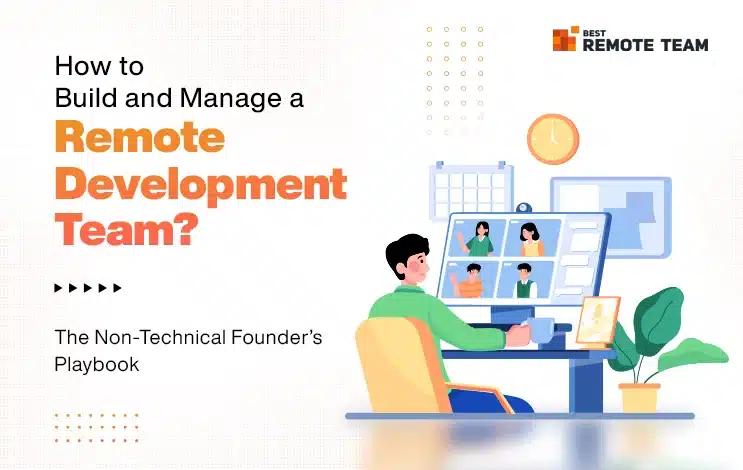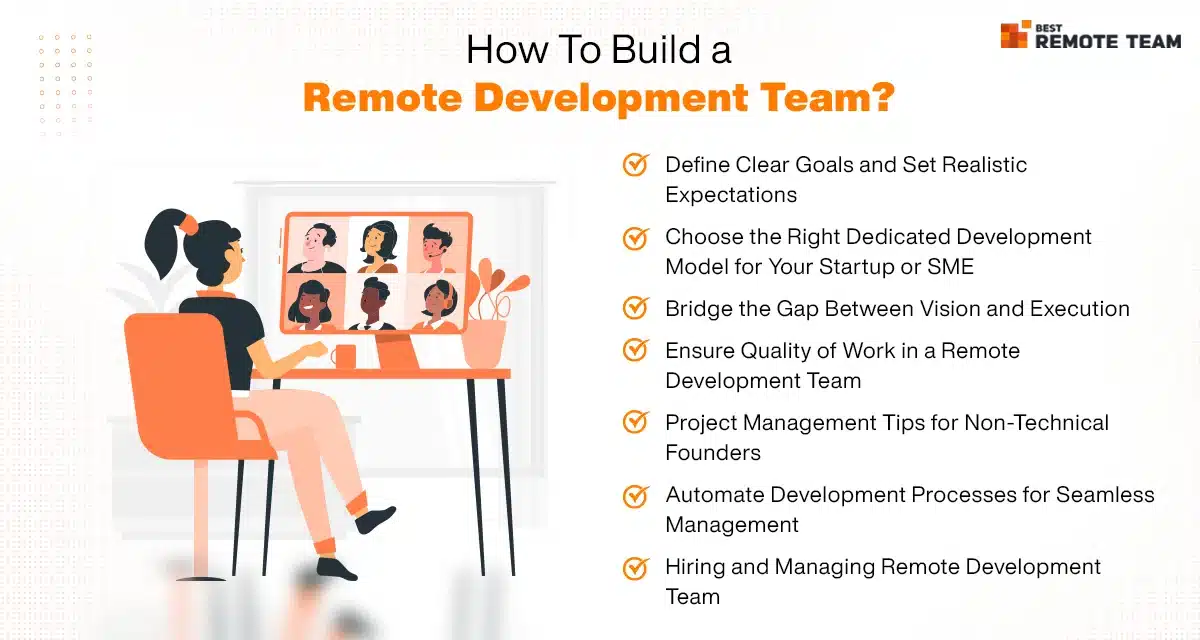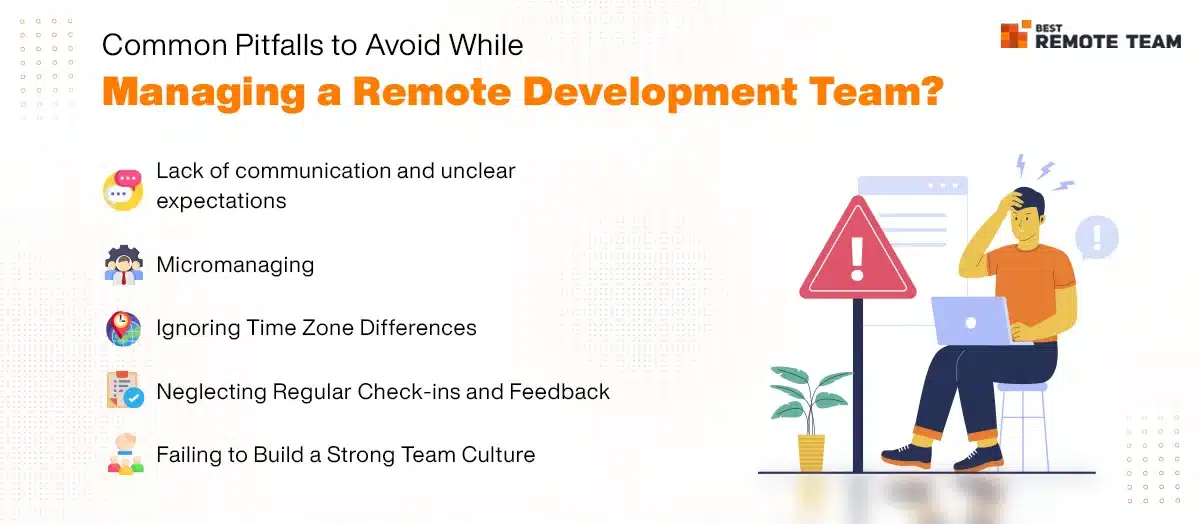How To Build A Remote Development Team?
Below is the step-by-step detailed explanation of how you should begin with finding and hiring the remote teams.
Step 1: Define Clear Goals and Set Realistic Expectations
Success can only be achieved when you have realistic expectations as a startup. Hence, you need to be very clear about your business goals, project requirements, and what type of remote team you need. Technological and technical requirements, timeline, budget, working method, communication, and much more.
When, as a founder, you are clear about what you want, you can easily hire and filter what type of team you can form and decide what type of experts are capable of working on your project.
Here is what you can do:
- Make a note of everything so it is easy to share with the candidate and explain to them. List project objectives, KPIs, and deliverables in brief.
- Define clear roles and responsibilities for remote developers.
- Mention tools you are using for project management, communication, and payment.
- Share your background, vision, and goals to the developer. This will help them understand more and think like you.
Step 2: Choose the Right Dedicated Development Model for Your Startup or SME
Once your requirements are clear, you can easily judge which development model will suit you best. This is important to focus because budget fluctuation can disturb your productivity, business, and overall relationship.
There are usually three development models: fixed, time and material, and dedicated development.
#1. Fixed Price Model
A fixed model is best for short-term projects when you are clear about every detail of the project, the goals, and what you want. As a startup, you are budding and exploring the market, so you can’t take the risk of hiring as a freelancer or on an hourly basis; hence, having a fixed priced model is best to complete the project in an organized way.
#2. Time and Material Model
This model is best for changing project requirements because you only pay for the task when it’s actually done. If you have long-term projects and need to deal with clients who are passionate about walking with advanced trends, then the time and material model is best for you. Because you can balance your budget and performance with perfect execution of a project.
#3. Dedicated Development Team Model
A dedicated model is best for scaling Startups who have a vision of continuous growth and have secure finance backup. As dedicated teams are expensive, it needs a future-proof idea and projects that have an assured chance of success. It is like you are hiring employees for your company who will work full-time for the projects.
Step 3: Bridge the Gap Between Vision and Execution
Your remote team needs to understand what they are building and why; hence, communicate everything transparently. You can show examples of other apps or software that is already live in the market to give a live demo. This will give a better understanding of your goal and vision and will help developers to use suitable strategies or tools to meet the expectations.
Keep checking in on project status every week to ensure everything is going all right. This will not take much time but will help in smooth project execution. Have a 5 to 10-minute meeting at the end of the week just to take an update on where we are and what’s next!
Make sure everything is transparent to make the remote work enjoyable and cooperative. For this, you can use slack or notion to assign tasks with dates and have a chat with other team members in a group.
Step 4: Ensure Quality of Work in a Remote Development Team
Obviously , you don’t need to worry when you are working with dedicated remote development team but implementing code review and QA are the crucial part of the project. You can also do this even if you are from a non-tech background, there are many websites and tools that can help check code quality and QA process. Set up automated testing and visions on github,bitbucket and other tools .
You can also monitor progress and maintain quality on tools like Jira and trello to see the bottlenecks of the project.
Step 5: Project Management Tips for Non-Technical Founders
Use agile methodologies like scrum and kanban so the remote teams can quickly respond to the changing project requirements. Using Agile project management is beneficial in many ways because this will need frequent communication in remote development, and the team will stay in touch during the entire project to make sure everyone is aligned.
This boosts teamwork and keeps the remote team motivated to bring the best results as a team.
Other than this, follow some basic tips for easy remote working.
- Discuss the communication strategies like task reporting style, email format, time for video call.
- Avoid working on weekends to give space and flexibility to the remote team.
- Automate task assignments, reporting, and reminders using tools like Zapier and GitLab CI/CD to save time.
Step 6: Automate Development Processes for Seamless Management
Automation and AI are now part of development, and every industry uses them. You can use it, too, for more productive work. Automating tasks like data entry, scheduling, testing, deployment, email management, and many more can make the project less stressful and more organized.
Hence, you can use automation tools like Jenkins, GitHubActions, etc, to increase work efficiency and balance work-life for you as well as the remote team working with you.
Step 7: Hiring and Managing Remote Development Team
Once you know everything about project needs, flow of working, tools, tech stack, methodology, and other things, it’s time to hire the right remote development team.
Here is how you can do it.
Check on Toptal, Upwork, Fiverr, and other reputed platforms for hiring remote developers. At this platform, there are usually experienced and working professionals so you can rely on them for the best project outcome.
Mention your requirement, guidelines or any suitable need clearly in the job description to attract only the suitable candidates.
Shortlist, interview, have a technical analysis, and basic QA with the shortlisted experts.
Form the team that fits your budget and ticks all the requirements.
Your job is done once the remote developers are onboarded; managing the remote development team is the responsible part here. If you need help building or managing your remote team, contact us — we’re here to support your journey.
Developers work for long-time where there is trust, loyalty, and growth. Make sure you are maintaining this standard while working to retain the talents.
Common Pitfalls to Avoid While Managing a Remote Development Team
Remote work is flexible, comfortable, and productive but it could lead to some consequences if you take managing a remote development team lightly.
#1. Lack of communication and unclear expectations
Even if you have explained it correctly but the remote developers got some misunderstanding, this can mislead the project and impact the result badly. Use structured communication tools like Slack, Microsoft Teams, and Notion to allow remote teams to check all the entire details of the project by going back and working on the right track.
Pro tip: add detailed documentation from start to end related to projects in the slack, teams, notion or developer’s group so that they can access and don’t have to wait for doubt clearance.
#2. Micromanaging
Too much control and your involvement will frustrate developers, while too little oversight can lead to missed deadlines. So, what you can do is maintain a balance. Trust your team and let them work flexibly and use their skills. Track the progress on tools like Jira, Trello, and Slack. If everything goes well, then well.
If anything needs to be improved, gently put the point during meetings or in groups to maintain the healthy remote work culture.
#3. Ignoring Time Zone Differences
Overlapping working hours can impact productivity. This is the common challenge of employees working remotely from different countries and regions but this can be solved by having a fixed time of meeting.
Pro tip: Close the communication lines after work hours and weekends. Allow flexibility to connect on personal numbers in case of urgency.
#4. Neglecting Regular Check-ins and Feedback
If you don’t check your project status regularly, it can go off track. Schedule weekly sprint reviews, progress updates, and one-on-one feedback sessions. This creates an organized and disciplined work culture.
#5. Failing to Build a Strong Team Culture
It is important to have a good bond among team members when working remotely otherwise, it can lead to other issues and affect individual performance. There are so many small things, like if a team member has made a mistake or is not able to do the task, the support and understanding from other team members will keep the project going smoothly with motivation and positivity.
Conclusion
Hope this article answers your question on how to build and manage a remote development team. You can’t build a great remote development team overnight. But with careful planning, clear communication, setting realistic goals, collaboration, and tracking, you can build and manage a remote team stress-free.
Every step is equal and important because consistency is the key. Other than this, keep evolving your process as your business scales. Motivate the remote team for continuous learning, feedback loops, and using automation to build a strong team culture. By implementing these strategies, you can effectively lead remote teams and turn vision into reality while maintaining efficiency, quality, and long-term growth.






